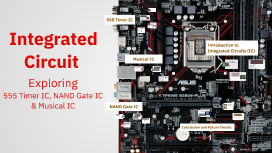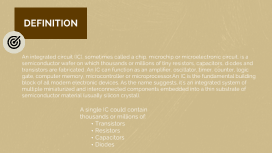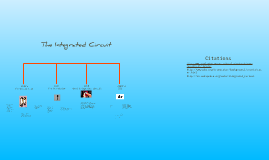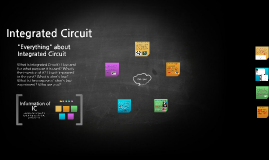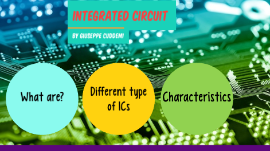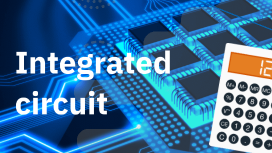INTEGRATED CIRCUIT
Transcript: Working Principle The 555 Timer works by utilizing resistors and capacitors to control charging and discharging time. In astable mode, it continuously oscillates between high and low states, generating square waves. 555 Timer IC The 555 Timer IC was introduced in 1972, designed to operate in different modes including astable, monostable, and bistable. Its simple design and low cost have made it one of the most popular ICs in electronics. 555 Timer IC Applications of 555 Timer The 555 Timer IC finds applications in various devices such as timers, pulse width modulation, tone generation, and oscillators. Commonly seen in alarms, timers, and flashing lights, it showcases versatility. PIN Diagram 555 Timer IC Introduction to Integrated Circuits Definition Integrated Circuit Musical IC An integrated circuit (IC) is a semiconductor device that combines multiple electronic components into a single package. ICs are fundamental to modern electronics, enabling complex functions in compact sizes, from simple logic gates to complete microprocessors. Integrated Circuit Musical IC Working Principle Importance in Electronics A Musical Integrated Circuit (IC) is a type of specialized electronic chip that is designed to generate musical tones or melodies when triggered. These ICs are typically used in toys, greeting cards, doorbells, alarms, clocks, and other consumer electronic devices where simple sound or music playback is needed. The working principle of the NAND Gate IC is based on its ability to perform logical operations. When at least one input is LOW, the output remains HIGH, embodying the essence of negation in digital logic. History & Evolution Integrated circuits are crucial in enabling modern technology, from smartphones to computers. They enhance performance, reduce power consumption, and allow for miniaturization, reshaping how devices are designed and operated. The first integrated circuit was developed in 1958 by Jack Kilby. Since then, IC technology has evolved through various generations, becoming smaller, faster, and more economical, leading to the widespread use of microelectronics in countless applications. Applications of NAND Gates Advantages and Limitations NAND Gates are widely used in digital systems, including memory devices, microcontrollers, and logic circuits. They serve critical functions in arithmetic operations and complex logic design. The advantages of NAND Gates include versatility in building various logic functions and low power consumption. However, they may introduce propagation delays, impacting circuit performance under certain conditions. Exploring 555 Timer IC, NAND Gate IC & Musical IC Summary of Key Points NAND Gate IC Integrated circuits, including the 555 timer and NAND gates, have revolutionized electronic design. Their compactness and efficiency enable innovative applications across various industries, from timers to complex digital logic systems. Future Developments in IC Technology Impact on Electronics Industry Emerging trends in integrated circuit technology include miniaturization, increased power efficiency, and advanced semiconductor materials. Innovations like artificial intelligence and Internet of Things (IoT) integration are driving the next generation of IC capabilities. NAND Gate IC Working Principle Integrated circuits have dramatically reduced costs and size while increasing functionality in the electronics industry. Their influence extends from consumer electronics to critical applications in healthcare and automotive systems, shaping modern technological landscapes. A NAND Gate IC combines multiple NAND gates on a single chip. It outputs a LOW signal only when all its inputs are HIGH, making it essential for implementing various logic functions in digital circuits. The working principle of the NAND Gate IC is based on its ability to perform logical operations. When at least one input is LOW, the output remains HIGH, embodying the essence of negation in digital logic. Advantages and Limitations Applications of NAND Gates The advantages of NAND Gates include versatility in building various logic functions and low power consumption. However, they may introduce propagation delays, impacting circuit performance under certain conditions. NAND Gates are widely used in digital systems, including memory devices, microcontrollers, and logic circuits. They serve critical functions in arithmetic operations and complex logic design. Conclusion and Future Trends






